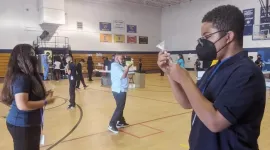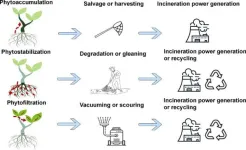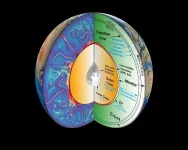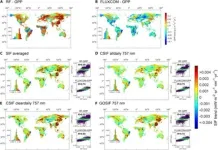(Press-News.org) A fish on land still waves its fins, but the results are markedly different when that fish is in water. Attributed to renowned computer scientist Alan Kay, the analogy is used to illustrate the power of context in illuminating questions under investigation.
In a first for the field of artificial intelligence (AI), a tool called PINNACLE embodies Kay’s insight when it comes to understanding the behavior of proteins in their proper context as determined by the tissues and cells in which these proteins act and with which they interact. Notably, PINNACLE overcomes some of the limitations of current AI models, which tend to analyze how proteins function and malfunction but do so in isolation, one cell and tissue type at a time.
The development of the new AI model, described in Nature Methods, was led by researchers at Harvard Medical School.
“The natural world is interconnected, and PINNACLE helps identify these linkages, which we can use to gain more detailed knowledge about proteins and safer, more effective medications,” said study senior author Marinka Zitnik, assistant professor of biomedical informatics in the Blavatnik Institute at HMS. “It overcomes the limitations of current, context-free models and suggests the future direction for enhancing analyses of protein interactions.”
This advance, the researchers note, could propel current understanding of the role of proteins in health and disease and illuminate new drug targets for designing more precise, better tailored therapies.
PINNACLE is freely available to scientists everywhere.
A major step forward
Untangling the interactions across proteins and the effects of their contiguous biologic neighbors is tricky. Current analytic tools serve a crucial purpose by providing information on the structural properties and shapes of individual proteins. These tools, however, aren’t designed to tackle the contextual nuances of the overall protein environment. Instead, they produce protein representations that are context-free, meaning that they lack cell-type and tissue-type contextual information.
Yet proteins play different roles in the different cellular and tissue contexts in which they find themselves and also depending on whether the same tissue or cell is healthy or diseased. Single-protein representation models can’t identify protein functions that vary across the multitude of contexts.
When it comes to protein behavior, it’s location, location, location
Composed of twenty different amino acids, proteins form the building blocks of cells and tissues and are indispensable for a range of life-sustaining biologic functions — from transporting oxygen throughout the body to contracting muscles for breathing and walking to enabling digestion and fighting off infection, among many others.
Scientists estimate that the number of proteins in the human body ranges from 20,000 to hundreds of thousands.
Proteins interact with one another but also with other molecules, such as DNA and RNA.
The complex interplay between and across proteins creates convoluted networks of protein interaction. Situated in and among other cells, these networks engage in many complex cross talks with other proteins and protein networks.
PINNACLE’s advantage stems from its ability to recognize that protein behavior can vary by cell and by tissue type. The same protein may have a different function in a healthy lung cell than it has in a healthy kidney cell or in a diseased colon cell.
PINNACLE sheds light on how these cells and tissues influence the same proteins differently, something not possible with current models. Depending on the specific cell type in which a protein network resides, PINNACLE can determine which proteins engage in certain conversations and which ones remain silent. This helps PINNACLE better decode the protein cross talk and the type of behavior and, ultimately, allows it to predict narrowly tailored drug targets for malfunctioning proteins that give rise to disease.
PINNACLE does not obviate but complements single-representation models, the researchers noted, in that it can analyze protein interactions within various cellular contexts.
Thus, PINNACLE could enable researchers to better understand and predict protein function and help elucidate vital cellular processes and disease mechanisms.
This ability can help pinpoint “druggable” proteins to serve as targets for individual medications as well as forecast the effects of various drugs in different cell types. For that reason, PINNACLE could become a valuable tool for scientists and drug developers to home in on potential targets much more efficiently.
Such optimization of the drug discovery process is sorely needed, said Zitnik, who is also an associate faculty member at the Kempner Institute for the Study of Natural and Artificial Intelligence at Harvard University.
It can take 10-15 years and cost as much as one billion dollars to bring a new drug to market, and the road from discovery to drug is notoriously bumpy with the end result often unpredictable. Indeed, nearly 90 percent of drug candidates do not become medicines.
Building and training PINNACLE
Using human cell data from a comprehensive multiorgan atlas, combined with multiple networks of protein–protein interactions, cell type-to-cell type interactions, and tissues, the researchers trained PINNACLE to produce panoramic graphic protein representations that encompass 156 cell types and 62 tissues and organs.
PINNACLE has generated nearly 395,000 multidimensional representations to date, compared to about 22,000 possible representations under current single-protein models. Each of its 156 cell types includes context-rich protein interaction networks of about 2,500 proteins.
The current numbers of cell types, tissues, and organs are not the upper limits of the model. The assessed cell types to date have come from living human donors and cover most, but not all, cell types of the human body. Moreover, many cell types haven’t been identified yet, while others are rare or hard to probe, such as neurons in the brain.
To diversify the cellular repertoire of PINNACLE, Zitnik plans to make use of a data platform that includes tens of millions of cells sampled from the entire human body.
Authorship, funding, disclosures
Additional authors on the paper include Michelle M. Li, Yepeng Huang, Marissa Sumathipala, Man Qing Liang, Alberto Valdeolivas, Ashwin N. Ananthakrishnan, Katherine Liao, and Daniel Marbach.Marbach and Valdeolivas are employed by F. Hoffmann-La Roche Ltd.; the other authors declare no competing interests.
Funding for the research was provided by the National Institutes of Health (R01HD108794; R01DK127171, P30 AR072577, T32HG002295), National Science Foundation (CAREER 2339524), United States Department of Defense (FA8702-15-D-0001), Harvard Data Science Initiative, Amazon Faculty Research, Google Research Scholar Program, AstraZeneca Research, Roche Alliance with Distinguished Scientists, Sanofi iDEA-iTECH Award, Pfizer Research, Chan Zuckerberg Initiative, John and Virginia Kaneb Fellowship award at HMS, Aligning Science Across Parkinson’s (ASAP) Initiative, Biswas Computational Biology Initiative in partnership with the Milken Institute, Harvard Medical School Dean’s Innovation Awards for the Use of Artificial Intelligence, and Kempner Institute for the Study of Natural and Artificial Intelligence at Harvard University.
END
New AI tool captures how proteins behave in context
PINNACLE predicts protein functions in cells and tissues, can help improve drug discovery
2024-08-16
ELSE PRESS RELEASES FROM THIS DATE:
Researchers investigate parent perceptions of virtual learning
2024-08-16
In response to the COVID-19 pandemic, a majority of schools across the U.S. shifted to virtual learning. In a new study, published in Social Education Research, researchers conducted interviews with parents of students who attended middle or high schools to understand how virtual learning impacted their daily routines, stress levels, and the academic performance of the children.
The transition to virtual learning necessitated the creation of online lessons in a very short time period and with limited training of teachers. As a result, parents and students had to deal with unexpected changes in their home lives and learning environments.
“Virtual learning will not be limited ...
Ancient DNA reveals Indigenous dog lineages found at Jamestown, Virginia
2024-08-16
Previous scientific studies have indicated that North American dog lineages were replaced with European ones between 1492 and the present day. To better understand the timing of this replacement, researchers from the University of Illinois Urbana-Champaign and the University of Iowa sequenced mitochondrial DNA from archaeological dogs. Their findings suggest a complex social history of dogs during the early colonial period.
Europeans and Native Americans valued their dogs as companion animals, using them for similar work and as symbols of identity. Consequently, ...
Researchers make breakthrough in fight against COVID-19
2024-08-16
A team led by Jose Onuchic at Rice University and Paul Whitford at Northeastern University, both researchers at the National Science Foundation Physics Frontiers Center at the Center for Theoretical Biological Physics (CTBP) at Rice, has made a discovery in the fight against severe acute respiratory syndrome coronavirus-2 (SARS-CoV-2), the virus responsible for COVID-19.
The team, in partnership with an experimental effort led by Yale University researchers Walter Mothes and Wenwei Li, has uncovered new insights into how the virus infects human cells and how it can be neutralized. Their findings were published in the ...
Methamphetamine-involved psychiatric hospitalizations have increased, study says
2024-08-16
AURORA, Colo. (August 16, 2024) – A new study, out now in Drug and Alcohol Dependence, that details trends among psychiatric hospitalizations between 2015-2019 finds that while most hospitalizations did not involve any substances, methamphetamine-related hospitalizations have increased while overall number of psychiatric hospitalizations remained stable.
Additionally, researchers detail that psychiatric hospitalizations caused by methamphetamine use were highest in the Mountain West region but were also shifting geographically. “Rates of ...
Green warriors: plants on the frontline against microplastics
2024-08-16
In an innovative ecological article, researchers have unveiled the potential of phytoremediation to curb microplastic pollution. This approach leverages natural plant processes to absorb and diminish micro and nanoplastics, offering a viable solution for managing environmental plastic pollution. This viewpoint advocates utilizing plant life as an effective tool against the widespread issue of plastic contamination in ecosystems.
With escalating concerns about the enduring impact of plastic waste, phytoremediation emerges as a promising solution. This method utilizes plants ...
Decoding mysterious seismic signals
2024-08-16
For the decades since their discovery, seismic signals known as PKP precursors have challenged scientists. Regions of Earth’s lower mantle scatter incoming seismic waves, which return to the surface as PKP waves at differing speeds.
The origin the precursor signals, which arrive ahead of the main seismic waves that travel through Earth’s core, has remained unclear, but research led by University of Utah geophysicists sheds new light on this mysterious seismic energy.
PKP precursors appear to propagate from places deep below North America and the western Pacific and possibly bear an association with “ultra-low velocity zones,” thin layers ...
Green light for accurate vegetation research: new evaluation of global SIF datasets
2024-08-16
A recent study has pinpointed the top-performing solar-induced chlorophyll fluorescence (SIF) products for precise global monitoring of photosynthesis and vegetation dynamics. By thoroughly evaluating eight widely-used SIF datasets, the research team identified Global OCO-2 SIF (GOSIF) and Contiguous Solar-Induced Fluorescence (CSIF) as leading tools for estimating gross primary productivity (GPP) and forecasting key phenological stages. These findings provide crucial direction for scientists aiming to enhance global vegetation ...
Mount Sinai researchers discover novel nanoparticles in blood with potential to transform cancer diagnosis
2024-08-16
New York, NY [August 16, 2024]—Scientists at the Icahn School of Medicine at Mount Sinai have identified a new class of RNAs packed into tiny particles known as extracellular vesicles (EVs) that could revolutionize how cancer and other diseases are diagnosed. The team found that these molecules undergo changes when cancer is present, suggesting their potential as biomarkers for detecting prostate cancer or as targets for therapy. The work, led by Navneet Dogra, PhD, Edgar Gonzalez-Kozlova, PhD, Tzu-Yi Chen, PhD, ...
Underground event marks excavation completion on colossal caverns for underground neutrino laboratory, DUNE
2024-08-16
Lead, SD (Aug. 15, 2024) — A ribbon-cutting event was held today at the Sanford Underground Research Facility (SURF) in Lead, S.D. to mark the completion of excavation work for the Long-Baseline Neutrino Facility/Deep Underground Neutrino Experiment (LBNF/DUNE), an international project led by the U.S. Department of Energy’s Fermi National Accelerator Laboratory. The “Into the Depths of Discovery” event, hosted by Fermilab and the South Dakota Science and Technology Authority (SDSTA), was attended by supporters of the three-year excavation of the caverns, including state and federal leaders as well as officials from the Department of Energy.
“Today ...
Exposing myths about ballot collection on Native American reservations
2024-08-16
Third-party collection of mail-in ballots has helped rural residents and those with disabilities to vote, yet the practice has become contentious and the target of laws aimed at restricting it.
Critics claim the process is vulnerable to fraud and manipulation.
But new research from the University of Utah’s College of Social & Behavioral Science tells a different story. Ballot collection is more accurately characterized as a pathway for legitimate voter participation, according to a study published last month. Authors Daniel McCool, a professor emeritus in the Department of Political Science, and Weston McCool, a ...
LAST 30 PRESS RELEASES:
Clearing the brain of aging cells could aid epilepsy and reduce seizures
Brain injuries linked with potential risk of suicide, new study finds
New technique lights up where drugs go in the body, cell by cell
New study finds movement of fishing fleets can reveal shifts in marine ecosystems
Embargoed: New evidence points to potential treatment for vascular dementia
Study uncovers disrupted brain balance in alcohol dependence
Working in groups can help Republicans and Democrats agree on controversial content moderation online
Structural findings reveal how distinct GPCR ligands create different levels of activation
Anything-goes “anyons” may be at the root of surprising quantum experiments
UC review: Maximizing workplace opportunity for veterans
From generation to complex control: Metasurfaces make perfect vortex beams "within reach"
Thin-film lithium niobate-based detector: recent advances and perspectives
Exploring why some people may tend to persistently make bad choices
How cells balance their protein levels
Nirsevimab vs RSVpreF vaccine for RSV–related hospitalization in newborns
Effectiveness and impact of maternal RSV immunization and nirsevimab on medically attended RSV in US children
AI gives scientists a boost, but at the cost of too many mediocre papers
Next-generation vision model maps tree growth at sub-meter precision
Genes aren’t destiny for inherited blindness, study shows
MIT study: High-fat diets make liver cells more likely to become cancerous
Exposure to multiple fine particulate matter components and incident depression in the US Medicare population
Risk of burdensome health care spending over time in the US
Nirsevimab against hospitalizations and emergency department visits for lower respiratory tract infection in infants
New microfluidics technology enables highly uniform DNA condensate formation
A new strategy for immune tolerance
Super Mario Bros. help fight burnout: New study links classic games to boosted happiness
Deepest gas hydrate cold seep ever discovered in the arctic: International research team unveils Freya Hydrate Mounds at 3,640 m depth.
Integrating light and structure: Smarter mapping for fragile wetland ecosystems
ACA-SIM: A robust way to decode satellite signals over complex waters
Probiotics can restore gut microbiome in breastfed infants
[Press-News.org] New AI tool captures how proteins behave in contextPINNACLE predicts protein functions in cells and tissues, can help improve drug discovery







